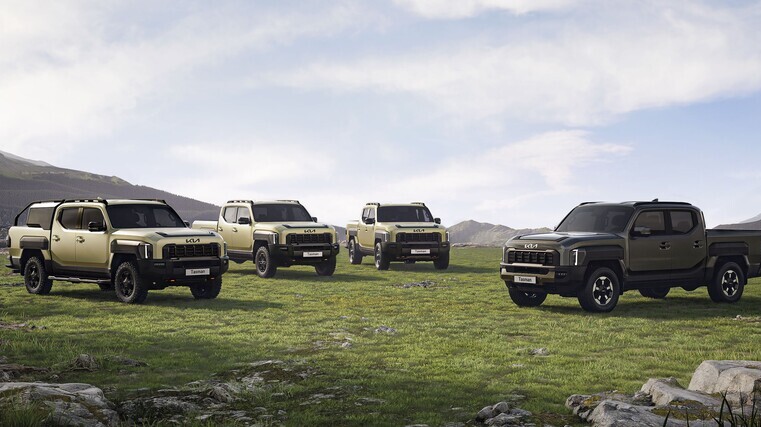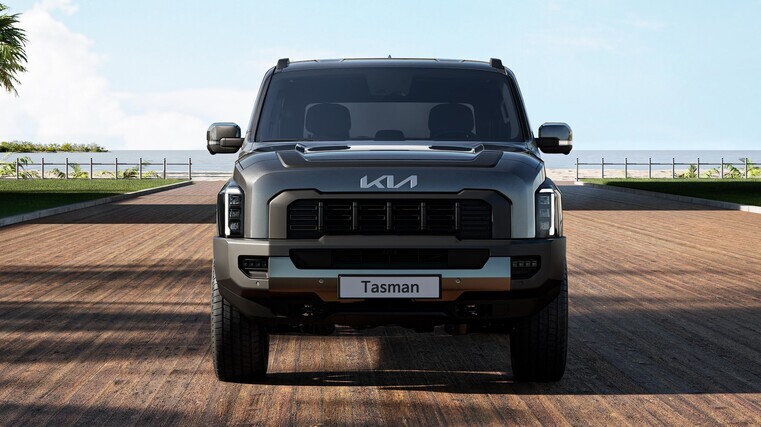Wraps come off Tasman
Kia has unveiled full details of its first ute, the Tasman, which “sets the benchmark” for the marque’s “future pick-up range”.
The model, which was officially unveiled at Jeddah Motor Show this week, will initially launch in South Korea in the first half of 2025 before heading to Australasia.
The Tasman is being offered as a double-cab base model, and in X-Line and X-Pro trim. The latter provides “superior” off-road performance thanks to its 28mm higher ground clearance, which totals 252mm.
It’s equipped with 17-inch gloss-black wheels with all-terrain tyres, while the X-Line features larger 18-inch alloys paired with highway and terrain rubber.
Additionally, Kia provides customisable chassis-cab variants along with single-cab options that optimise bed space by reconfiguring the passenger compartment into a single-row layout. That said, information regarding the local model range and its specifications will be provided at a later date.
A range of accessories will be available to enhance leisure and work activities, enabling owners to tailor their orders.
The ute will be offered with four bed accessory configurations – single decker, double decker, sports bar and ladder rack with the first three available from launch. In addition, there will be 13 accessory products offered, including two types of side steps and beadlock-style wheels.
The single decker features a canopy and butterfly doors for easy access, and a roof rack for a rooftop tent. The double decker has a trunk equipped with butterfly doors and a sliding tonneau cover for customisable cargo space.
The sports roll-bar variant comes with a functional frame for mounting lifestyle items. The final variant features a ladder-type rack and is compatible with rooftop tents.
Based on a fully optimised body-on-frame platform, the Tasman will be offered in South Korea with a 281PS and 2.5-litre petrol engine mated to an eight-speed automatic transmission. With 421Nm of torque, it can accelerate from 0-100kph in 8.5 seconds and onto a maximum speed of 185kph.
Down under, the pick-up will feature a 210PS 2.2-litre diesel engine paired with an eight-speed automatic transmission. Producing 441Nm of torque, it can make the 0-100kph dash in 10.4 seconds while the top speed remains unchanged.
In other regions, such as the Middle East and Africa, customers can choose between the 2.5-litre petrol and 2.2-litre diesel engines.
Utilising an optimised composite bush structure to mount the Tasman’s body to the frame-type chassis ensures improved rigidity, body control, stability and comfort.
The double wishbone front-suspension units have been developed to improve ride and handling. The rear features a rigid axle with leaf springs for robustness and load-carrying capability, incorporating vertically mounted shocks to ensure more effective damping and greater control.
Capabilities provided by the front and rear suspension units are enhanced by Kia’s frequency selective sensitive damper control and hydraulic rebound stop technology. These further minimise cabin vibration, and improve body control and comfort.
Safe all-terrain driving
Kia’s engineers have positioned the air intake inside the fender so all variants can ford water up to 800mm deep at 7kph. Further water-ingress prevention measures, such as waterproof connectors for selected interior parts, protect critical components.
The all-terrain drivetrain technology has been tested and proven in numerous locations, including Sweden’s snowy tundra, scorching deserts in the Aussie outback, and steep inclines in the US and South Korea.
The X-Line and the X-Pro have all-wheel-drive (AWD) as standard, which is an option on the base model.
This system switches automatically to the configuration required to provide optimum traction on different surfaces and offers three driving modes – eco, smart and sport – with terrain modes available within these settings depending on the market.
The X-Pro provides an additional rock mode for mountainous terrains. In the Middle East and Africa, desert, mud, snow and rock modes are fitted to AWD models. In Australasia and other general markets, AWD variants have sand, mud, snow and rock modes.
Further enhancements to the X-Pro include an automatically engaging rear electronic locking differential (e-LD) and X-Trek mode.
X-Trek enables the ute to maintain a low speed off-road without the need for manual acceleration or braking. The e-LD, which is located in the rear differential, provides advanced control over locking and unlocking to boost off-road adaptability and control.
Kia’s ground-view monitor provides drivers using the Tasman’s camera and infotainment screens to show what’s going on at ground level.
Design – inside & out
Kia’s design team has “deliberately shunned the familiar form language that has dominated the pick-up genre for decades”.
The marque adds: “This approach strips away the unnecessary to begin with a basic, honest form that highlights the vehicle’s sense of solid power through simple yet functional elements, without relying on oversized styling that dominates the segment.”
The Tasman has an expansive radiator grille and bumper design, which emphasises its width, while the hood trim and grille frame Kia’s familiar “tiger face” featuring vertically oriented signature lighting in the headlamps.
The upright windshield and rear glass contribute to the Tasman’s silhouette, reinforced by the 45-degree angles of its graphic elements. The fender design combines practical functions, such as headlights and storage units.
The tailgate showcases a stamped logo, while the tailgate’s handle and high-mounted stop-lamp are integrated for enhanced functionality.
Nine exterior colours are available – clear white, snow-pearl white, steel grey, interstellar grey, cityscape green, runway red, aurora black pearl and new hues, tan beige and denim blue.
Inside, large air vents featuring a honeycomb pattern – a key theme of the interior – emphasise the ventilation’s functionality.
A multi-function steering wheel, and minimalist lower centre dashboard and tunnel sections, provide intuitive control of the Tasman’s advanced technology. “Sophisticated” shapes and details throughout the cabin “raise the bar further for pick-up interior design”.
State-of-the-art 12.3-inch plus 5-inch plus 12.3-inch panoramic widescreen technology gives the driver and passenger access to vehicle controls and infotainment options.
An optional eight-speaker Harmon Kardon premium audio system allows users to take full advantage of the standard-fit Apple CarPlay and Android Auto integration.
The ute’s features and equipment include a large folding console table, dual wireless charging pads and hidden storage bins concealed beneath the rear seats offering class-leading storage capacity of 33 litres.
The Tasman boasts best-in-segment headroom, shoulder room and second-row legroom of 940mm. The rear seats can recline between 22 and 30 degrees. Its interior trim is available in five colours.
Included are the brand’s 10 “must have” sustainability items, such as a crash pad made from bioplastics, seats crafted with recycled PET fabric and bio-PU synthetic leather, a paint composition that includes BTX-free and bio-paint, and an interior carpet made from recycled PET material.
Practicality & technology
The Tasman’s standard-fit items include corner steps for easy access to the illuminated load bed. A power outlet for hand tools or laptops, and a sliding cargo floor that makes loading and unloading materials and equipment more convenient, are optional.
Along with divider-forming capabilities for the bed, the ute offers optional bedside flexibility with a mini-table for items such as a Bluetooth speaker or cup.
Inside, the folding console table allows “transition from a work vehicle to a mobile business space. This gives users the opportunity to use their laptop for work or relaxation”.
The Tasman’s load bed is 1,512mm long, 1,572mm wide and 1,186mm between the wheels, and 540mm deep for best-in-class cargo capability of 1,173 litres.
Thanks to a multi-skeleton, highly strengthened bed structure, it can carry a maximum payload of 1,195kg in two-wheel drive in addition to a 3,500kg towing capacity.
The marque says: “Features such as enhanced sound-deadening materials, additional wind-sealing strips and advanced noise extractor technology provide a hushed, vibration-free cabin ambience not typically available in the sector.”
The ute’s advanced driver assistance systems (ADAS) features include lane-keeping assist, blind-spot collision warning and remote parking assist.
It has also been optimised with trailer-profile functionality. This enables the trailer’s specification to be incorporated into the ADAS, which then automatically optimises driving characteristics.
Ho Sung Song, Kia’s president and chief executive officer, says: “Our first-ever pick-up truck was created from the ground up to transform the market and respond to the growing preference for lifestyle-orientated trucks with advanced features.
“The Tasman combines true pick-up values with exceptional capability, practicality and advanced features that defy conventional thinking. This essence is instilled in our global slogan ‘dive into a new dimension’.”














